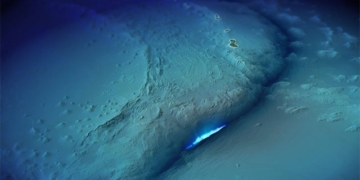The fear of the unknown is a deeply rooted instinct in humans, a sensation tied to existence since ancient times.
Facing dark, dense forests or gazing into the depths of vast waters, this natural fear is amplified by the mysteries they hold. Among these, deep lakes and the deep sea—challenging aquatic environments—are not only symbols of danger but also gateways to significant scientific discoveries.
However, are these two environments truly alike? The answer is no. While both share common characteristics of great depth, immense water pressure, and dim light, differences in origin, geomorphology, and ecosystems have created two distinct aquatic worlds with varying challenges and opportunities.
Myths and Cultural Influence
Since ancient times, both deep lakes and the deep sea have been popular subjects in mythology, folklore, and spiritual beliefs. In the “Shan Hai Jing”, an ancient Chinese text, deep lakes are described as the habitats of mythical creatures, such as fish with three tails, six legs, and red fur. Such stories not only ignite the imagination but also reinforce the fear of treacherous waters.

Myths not only ignite the imagination but also reinforce the fear of treacherous waters. (Illustrative image).
Similarly, many deep lakes around the world, such as Loch Ness in Scotland, have become legendary due to rumors of mysterious monsters. However, the deep sea seems less tied to mythology, largely because its vastness and remoteness made it difficult for ancient people to access and imagine.
Geological Origins: Two Distinct Journeys
The formation of the deep sea and deep lakes is closely linked to the movement of tectonic plates on Earth, but the processes that led to their creation are very different.
The deep sea, with its vast basins, is formed by the expansion of the ocean floor and the subduction of tectonic plates. Major rivers flow into the ocean, carrying sediments that create the continental shelf—a gently sloping transitional area from land to the deep sea, usually no more than 200 meters deep. The continental shelf is rich in life and provides a conducive environment for human activities.
Deep lakes, on the other hand, often form due to the influence of specific geological structures. A prime example is Lake Baikal, the world’s deepest lake, reaching depths of up to 1,637 meters. This lake lies on an ancient rift zone in Siberia, where tectonic movements have created steep cliffs and bottomless depths close to the shore. Lacking a continental shelf, deep lakes exhibit steeper topographical features, creating a chilling sensation when looking down.

The formation of the deep sea and deep lakes is very different.
Geomorphological and Landscape Differences
Standing before the ocean, one can easily see a vast continental shelf stretching offshore, with a gently sloping terrain facilitating human access. In contrast, deep lakes typically have steep shorelines and rapidly changing depths.
Imagine standing on the shore of Lake Baikal. Just a few footsteps from the water’s edge, the lake’s depth exceeds human height, creating the sensation of falling into an abyss. These characteristics not only render deep lakes mysterious but also limit human activities, creating a world entirely separate from the deep sea.
The narrow fjords of Norway serve as another example of unique deep lake geomorphology. These fjords, formed by glacial erosion, are surrounded by high cliffs and extremely deep waters, creating a spectacular yet challenging landscape.
Ecology: Adapting in Harsh Conditions
While both the deep sea and deep lakes are harsh environments, their ecosystems exhibit different adaptations.
In the eternal darkness, high pressure, and near-freezing temperatures of the deep sea, life persists through remarkable survival strategies. Some deep-sea fish have enormous mouths to capture rare prey, while some invertebrates utilize chemosynthesis to derive energy from hydrogen sulfide instead of sunlight. Bioluminescence is also a prominent feature, helping these species attract prey or communicate in the dark.
Deep lakes, despite having similar harsh conditions, face greater challenges related to oxygen depletion. In some eutrophic lakes, algal blooms and organic decay can deplete oxygen, creating “dead zones.” Nevertheless, endemic species like the “monster eel” find ways to adapt, demonstrating the resilience of life.

Both the deep sea and deep lakes are harsh environments.
Exploration: Risks and Opportunities
Exploring the deep sea has long posed a significant challenge for science. The immense water pressure, enveloping darkness, complex seabed terrain, and communication issues make expeditions dangerous and costly. Nevertheless, the scientific value of the deep sea—from discovering new species to seeking energy sources and deciphering Earth’s geological history—continues to attract numerous researchers.
In contrast, exploring deep lakes is relatively less complex, yet equally intriguing. Some lakes, like Lake Baikal, contain substantial amounts of methane gas beneath their floors, opening up potential energy extraction opportunities. However, cultural barriers, such as spiritual beliefs or mysterious legends, can sometimes hinder scientific exploration.


















































